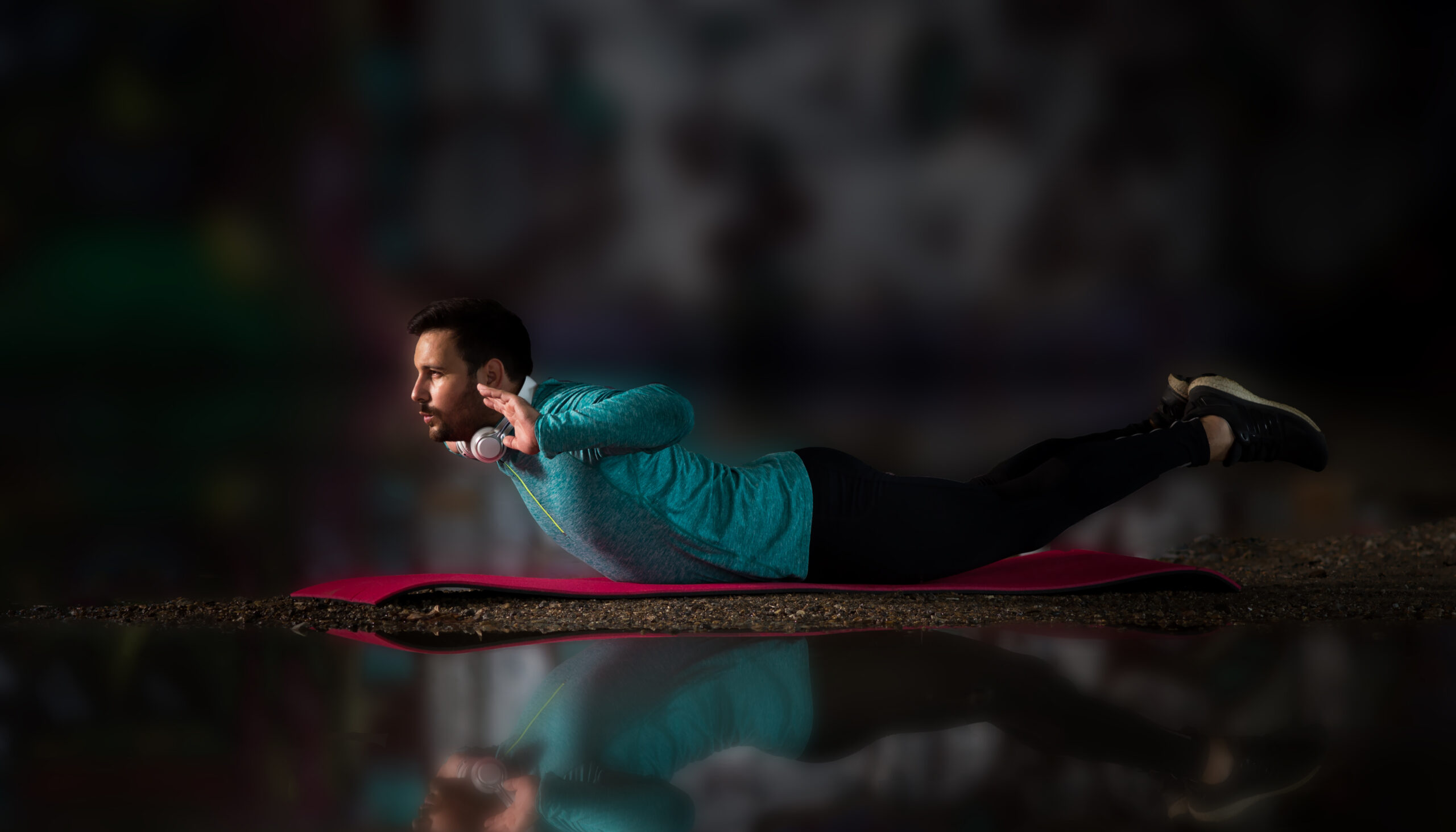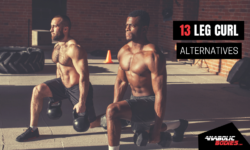In this inclusive piece, we’ll break down everything from what these exercises are to why they’re necessary and how to choose the right ones for you. Not only that, but we’ll dive into which muscles each move targets and even provide seven exercises worth adding to your regimen.
We’ve done all the hard work so that you don’t have to – including helpful tips on programming to help plan out your workouts better. Regardless of where you’re at in your fitness journey, incorporating these movements can effectively strengthen not only your lower back but beyond as well. Keep reading to learn more!
What are Back Extension Alternatives and Why Use Them?
If you’re like me and struggle with traditional back extensions due to discomfort or injury, don’t stress. There are other exercises that work the same muscles without the pain. These are called back extension alternatives and they provide a refreshing change to your workout routine.
Not only do these exercises target the same muscles as regular back extensions, but they also benefit other muscle groups too! For example, Barbell Good Mornings require total body stabilization for motor development, working both your lower back and much more.
Adding variety to your fitness regimen can give you greater range of motion and added benefits beyond what basic exercises offer. So while I’m not dismissing the tried-and-true effectiveness of core exercises such as back extensions, incorporating different workouts into your routine can produce impressive results in no time!
Check out some popular Back Extension Alternatives here if you’re keen on switching things up.
Key Considerations for Selecting Back Extension Alternatives
When selecting the right back extension alternative, it is important to consider several factors. First and foremost, the alternative exercise should target the same muscles as a traditional back extension. Additionally, you should select an exercise that accommodates any physical limitations or injuries you may have. Another factor is your fitness level and experience with strength training, as some alternatives are better suited for advanced lifters. Finally, consider whether the equipment needed for the alternative exercise is available at your gym or home gym setup. Taking these considerations into account will ensure that you are able to safely and effectively replace back extensions in your workout routine while still achieving similar muscle activation and growth.
Muscles Targeted by Back Extensions and Their Alternatives
When I’m working on my back extensions, I know that the main muscles getting hit are my erector spinae, glutes, and hamstrings. But there’s always room for variety in our workouts! That’s why I like to mix it up with some alternative exercises that focus on these muscle groups in unique ways.
For example, have you ever tried the Barbell Good Morning? It’s a killer exercise that really focuses on your erector spinae and hamstrings while also engaging your glutes. Or how about the Dumbbell Deadlift? This move works both your lower and upper back muscles while incorporating those legs into the lift.
If you’re looking for a full-body workout with an emphasis on your gluteus maximus (who isn’t?), then Barbell Deadlifts might be perfect for your routine.
Another great alternative is Bulgarian Split Squats. These bad boys not only help strengthen your quads but they also activate hip flexors to improve stability around knees and hips.
And if you’re specifically targeting those hamstrings… well let me introduce you to Glute Ham Raises. These babies isolate those hammies better than any old Back Extension ever will.
See what I mean? With so many alternatives targeted towards different sets of muscles, it’s never too late to make tweaks in our fitness programs and accommodate all training objectives for our entire body.
7 Best Back Extension Alternatives
If you’re looking for ways to strengthen your lower back without resorting to traditional back extensions, don’t worry! I’ve got you covered. Here are my top seven alternative exercises:
- Barbell Good Morning: Put a barbell across your upper back and bend forward at the hips. This movement targets not only your lower back but also your hamstrings.
- Dumbbell Deadlift: If low-back pain is an issue, try dumbbell deadlifting instead of with a barbell.
- Barbell Deadlift: While mostly thought of as a leg exercise, this lift also targets many muscles in the body like the lower back.
- Bulgarian Split Squat: Perfect for enhancing both quadriceps strength and unilateral stability, this single-leg squat variation requires coordination and balance.
- Glute Ham Raise: Working on extending hip muscles during running or jumping activities via glutes and hamstrings requires lower-back strength at every stage of motion too!
- Kettlebell Swing: Want to generate power from legs straight up through core/shoulders (back) explosively? Then feel free to use dynamic kettlebells which allow speed before thrusts with hips!
- Superman Pose: For an excellent bodyweight alternative targeting lower-back muscles plus glutes/hams/quads using various movements such as standing/walking/jumping/bending/reaching etc., look no further than this classic pose!
Barbell Good Morning
The Barbell Good Morning is an excellent exercise for targeting the posterior chain and strengthening lower back, glutes, and hamstrings. It can be considered a compound movement because it involves multiple joints working at once. The movement pattern mimics that of bowing forward like one would do while greeting someone in the morning.
To perform this exercise:
- Stand with your feet shoulder-width apart and place a barbell on your traps or across your shoulders.
- Engage your core, keep your spine neutral, and bend forward from the hips.
- Continue lowering until you feel a stretch in your hamstrings but do not allow your lower back to round or flex.
- Drive through the heels to extend and return to standing.
It’s important to use proper form throughout the entire movement to avoid any unnecessary stress on the lower back muscles or spine. A slight variation of this exercise includes holding each end of a resistance band instead of using weights which can provide a more gentle approach while still being effective.
Incorporating Barbell Good Mornings into your workouts can help correct muscle imbalances by building foundational strength in underdeveloped areas – ultimately preventing injuries related to weak musculature around these regions.
Dumbbell Deadlift
I absolutely love dumbbell deadlifts as a substitute to back extensions. It’s an exercise that greatly targets my hamstrings and glutes, all while also working on the muscles in my lower back. What I love most about this exercise is that it can be done with a single or pair of dumbbells – this makes adjusting weights based on your strength level a breeze!
To get started, grab hold of the dumbbells and stand with your feet shoulder-width apart. Keep your core engaged, slowly lower yourself towards the ground while bending at both hips and knees until you reach mid-shin level. Once you’re there, simply push through your heels to return to standing position.
If you want to mix things up, consider trying out some variations like sumo and staggered stance. By doing so, you’ll be able to target different muscle groups such as inner thighs and quads respectively. Just remember – these modifications might require lighter weight than a standard Deadlift! But trust me, incorporating them into your workout routine can lead impressive benefits for functional fitness.
Overall, I highly recommend adding some dumbbell deadlifts into your usual routine! They’re an amazing way to activate multiple muscle groups simultaneously without the risk of injury! For more info on other great exercises check out Glofox’s website at https://www. glofox. com/en-au/blog/
Barbell Deadlift
As someone who loves to work out, one of my go-to exercises is the Barbell Deadlift. It’s an awesome alternative to back extensions that targets various muscle groups in your body. This compound exercise mainly targets your erector spinae, glutes, hamstrings, and quads – making it a top choice for those looking to strengthen their lower back muscles while also focusing on enhancing their lower body strength.
So how do you perform this exercise? Start by standing with feet shoulder-width apart behind a loaded barbell. Keep your arms straight and chest up – then hinge down at the hips until you can grip the bar from above while keeping shins vertical. Take a deep breath in and brace your core before driving through heels to stand up whilst pulling the weight towards you using legs and hips.
It’s crucial that you maintain proper form when performing this exercise as failure to do so may result in injury. Ensure that you engage your core muscles throughout to keep your spine neutral. Avoid rounding of the back or rolling forward of shoulders as these positions increase risk of injury like muscular strains or worse.
To shake things up and add some variation, consider switching things up: try taking it slow or experimenting with different types of grips (like switch grip or hook) – even adjusting your stance width can help target specific areas more effectively!
Bulgarian Split Squat
Bulgarian Split Squat is an excellent unilateral exercise that primarily targets the quadriceps and glutes. To perform this exercise, stand with your back facing away from a bench or sturdy elevated surface. Place the top of one foot on the bench behind you and step forward with your other foot to assume a split squat position. Tighten your core muscles, keep your chest up and lower down towards the ground by bending your front knee. Make sure to keep your knee in line with your toes and not let it cave inwards or outwards.
Variations can be made with Bulgarian Split squats using dumbbells or barbells held at each side of the body for increased resistance. Additionally, performing single-arm Bulgarian split squats will challenge core stability while placing even greater emphasis on unilateral leg strength.
Because this is primarily a lower-body exercise, you want to make sure you supplement it with exercises focusing on other areas such as upper body pulling (rows/pull-ups), pushing (bench press/overhead press) movements to create balance in programming.
Adding Bulgarian split squats to any workout routine may help improve balance, flexibility, and coordination while increasing strength throughout both legs individually. It’s also great for developing lower-body muscular endurance which translates well into activities like running, long-distance walking or hiking where actions are repetitive but unevenly distributed between legs over long periods of time.
Glute Ham Raise
I absolutely love the Glute Ham Raise (GHR) as a substitute for back extensions, especially when it comes to strengthening my hamstrings and glutes! This exercise is an excellent way to work out your posterior chain while also replicating running or sprinting mechanics.
First things first, make sure you have access to a GHR machine or Roman chair. Then get on it and kneel on the pad with your feet secured under the foot anchors. Slowly lower yourself forward until you reach your limit without face planting onto the floor. Next, use all of your might to contract those hammys and glutes and raise yourself back up!
It’s important to maintain proper form throughout every single rep while performing GHRs. Keep your hips straight, engage that core, and avoid over-arching or unnecessary waist-bending.
If you’re just starting on this journey with GHRs, I recommend band-assisted reps initially until you’re more comfortable doing them alone. Add these compound movements into your training regimen because they can greatly increase strength gains in other exercises like squats, lunges, and deadlifts!
Kettlebell Swing
I absolutely adore the Kettlebell Swing, it’s a fantastic full-body exercise that focuses on those hard-to-reach posterior chain muscles, including the buff back, bodacious glutes, and healthy hamstrings. You’ll also find that this move straightens your posture, gives you an iron grip (important for opening stubborn jars!), and torches calories like nobody’s business.
To get started with this move, plant your feet shoulder-width apart and grasp your kettlebell tight with both hands between your legs. From here, bend over slightly at the hips as you swing the kettlebell backwards through them. Then give it all you’ve got by thrusting your hips forward fast to raise that bell all the way up to shoulder height! As it travels back down towards its starting position – get ready – repeat!
Remember: throughout each swing motion make sure to keep your core principles engaged (pun intended) and maintain a neutral spine position for safety reasons. Can’t afford any unnecessary strains on our sensitive lower-backs now can we?
Of course – as with any kind of weightlifting or resistance training exercises incorporating a moderate amount of Kettlebell Swings into your workout routine can prove to be beneficial when performed correctly with lighter weights until proper form is established before progressing to increased load or intensity levels gradually. Why not try out incorporating them into complementary muscle group workout days like abs or lower-back sessions? Your bod will thank you later!
Superman
I’ve found the perfect way to target my erector spinae muscles: the Superman! This bodyweight exercise does wonders for my vertebrae supporters, which run up and down my spinal column. It’s a simple move that involves lying on your stomach with your arms extended straight ahead of you and legs stretched out behind. Then, with correct form, lift your chest, arms, and legs off the ground at the same time while keeping a straight spine before bringing it all back to the start position.
This exercise has so many variations that can make it even more challenging like adding weights or performing it on an unstable surface like a Swiss ball. Did I mention it’s great for improving posture and preventing lower back pain caused by weak muscles in the lower back?
When I first started incorporating Supermans into my workouts, I urged myself to focus on proper shape above everything else. Injury prevention is key. But as I progressed over time, I kept building up incrementally until eventually reaching 3 sets of 12-15 repetitions; remembering to mindfully rest between sets.
Overall if you’re seeking an alternative to traditional back extensions that’ll skyrocket your core strength with just bodyweight – look no further than Superman!
Programming Tips
When incorporating back extension alternatives into your workout routine, there are a few programming tips to keep in mind. First, it’s important to start with lighter weights and perfect your form before increasing the weight. This will help you avoid injury and ensure you’re targeting the correct muscles.
Additionally, consider incorporating these exercises as assistance movements rather than focusing on them as primary exercises. For example, if you’re a powerlifter working on improving your deadlift, try incorporating dumbbell deadlifts or barbell good mornings into accessory work rather than replacing the main movement entirely.
Finally, remember to vary your routine to prevent plateauing or boredom. Try swapping out different back extension alternatives each week or every other week to keep things fresh and challenge yourself in new ways.
With these programming tips in mind, you’ll be able to incorporate back extension alternatives effectively into your workouts and see improved strength and muscle development over time.
Conclusion
As my workout routine got repetitive, I decided to try incorporating some back extension alternatives into it. The results were amazing! Not only did they target the muscles of my back and legs, but they also helped alleviate my lower back pain.
Choosing which alternatives would work best for me required considering certain factors like equipment availability, fitness level, and specific goals for each exercise. But after exploring different options, the 7 best back extension alternatives discussed in this article stood out as excellent choices.
I must say that focusing on proper form during each exercise is crucial to ensure effectiveness and reduce injury risk. Hence, be sure to listen to your body’s needs and adjust accordingly. These alternatives alongside a well-balanced fitness routine can help improve overall strength and fitness levels – highly recommended!
So if you’re looking to switch up your exercises or target specific muscle groups with challenging yet effective options? Look no further than these back extension alternatives!

Eddie Johnson is an ex-bodybuilder, fitness addict, writer, editor and founder of Anabolic Bodies. Also a proud father of two boys and passionate about bodybuilding, nutrition, and the science behind modern-day supplementation.




